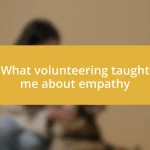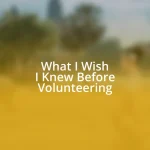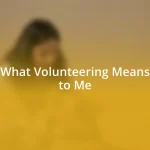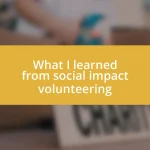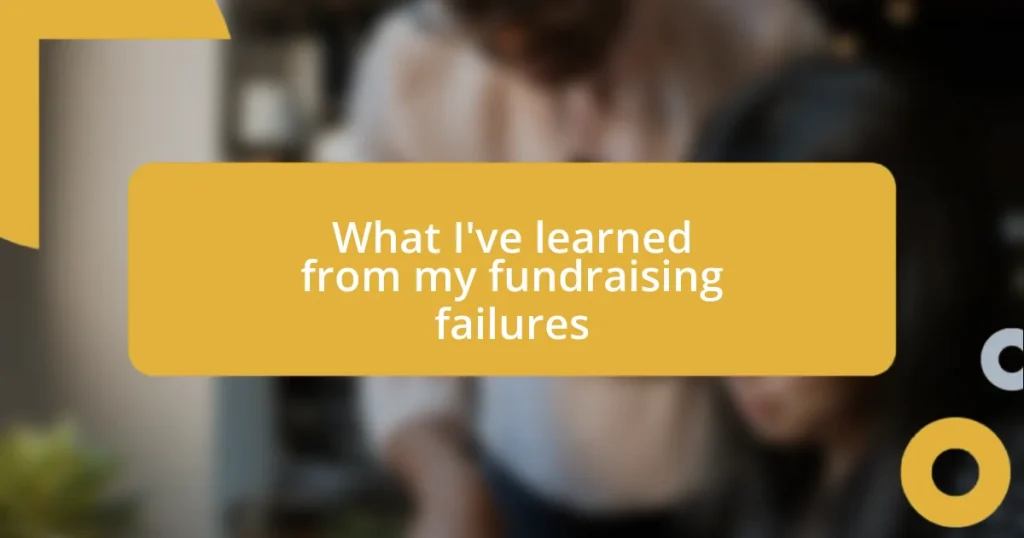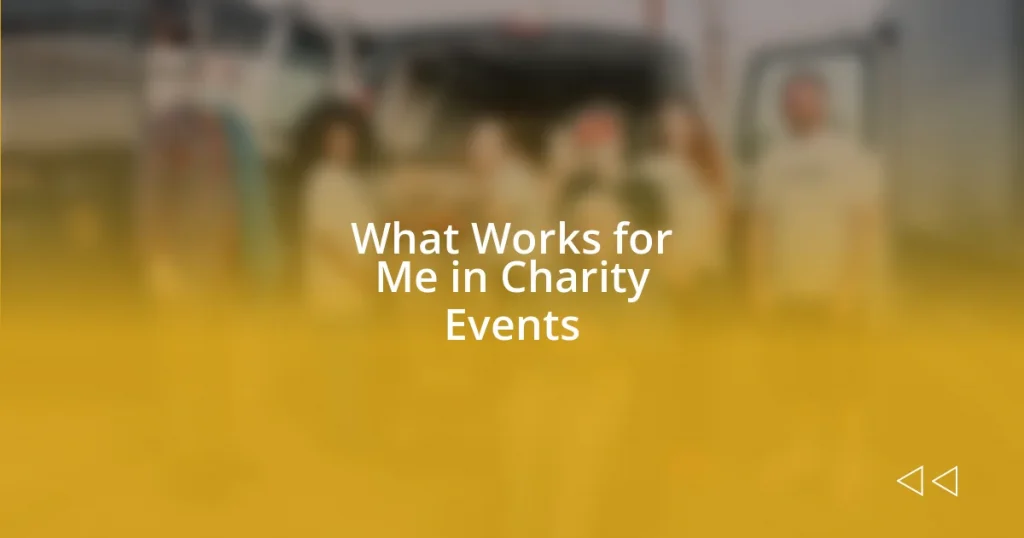Key takeaways:
- Emotional connections and genuine relationships with donors are crucial for successful fundraising; statistics alone don’t drive contributions.
- Learning from failures, such as the importance of follow-ups and engaging narratives, can transform future fundraising efforts and strategies.
- Effective donor communication, including personalized messages and transparency, fosters trust and builds long-lasting relationships with supporters.

Understanding fundraising failures
Fundraising failures can be hard to digest, but they offer some of the most valuable lessons. I remember my first big campaign—it was exciting, but I was so focused on the target that I overlooked building genuine relationships with potential donors. Why is it that sometimes the simplest elements slip through our fingers?
Reflecting on those setbacks, I realized that emotional connections drive donations more than statistics ever could. I once approached a donor with a dry pitch, reciting numbers and charts, only to walk away with empty hands. Have you ever experienced a moment where you knew you missed a vital chance to truly engage someone?
Understanding why a campaign failed requires a willingness to look inward and assess not just the strategy, but the heart behind it. Sometimes, it’s unsettling to confront our own missteps, but each failure pushed me to question what went wrong, allowing me to grow and adapt. What insights can we uncover from those tough moments to make our next campaign stronger?

Analyzing personal experiences
Analyzing personal experiences has been a revealing journey for me. I once organized a charity event that flopped spectacularly. My team and I had high expectations, but we forgot the importance of proper communication. There we were, with an underwhelming turnout, sitting among the empty chairs, grappling with what went wrong. It was a sobering moment, one I still consider pivotal in how I approach fundraising today.
- I learned that clarity is crucial—everyone should understand their role in a campaign.
- I realized I needed to cultivate a community, not just an audience.
- Focusing on engaging narratives, rather than just cold facts, can resonate more deeply.
- Lastly, I discovered the value in seeking feedback; it’s essential for growth.
Without those painful experiences, I wouldn’t have unearthed these insights that now guide my fundraising efforts. Each failure felt like a rough patch, but they ultimately shaped my approach and the relationships I fostered along the way.

Identifying key mistakes made
Identifying key mistakes made has been a crucial step in my personal and professional growth. I vividly remember a time when I relied too much on online campaigns without considering the power of in-person interactions. We launched a social media blitz, but I soon noticed low engagement from actual supporters. It kicked off a realization: sometimes, the digital connection isn’t a substitute for heartfelt conversations face-to-face. Have you ever felt that disconnect when you’re trying to convey passion through a screen?
One significant mistake I’ve seen is underestimating the importance of follow-up. I approached multiple potential donors after a pitch, excited about the possibilities—but failed to check back. A simple email or phone call could have sparked renewed interest, but instead, I let my hopes slip away. It’s a reminder that persistence can yield fruit, and that a soft touch is often needed after the initial ask.
Lastly, I learned that not having a solid plan for donor engagement after an event can lead to missed opportunities. After a fundraiser, I was riding high on success and forgot to maintain those relationships. It felt like watching a beautiful sunset fade away; once it was gone, I grasped the urgency of nurturing connections instead of taking them for granted.
| Key Mistake | Insight Gained |
|---|---|
| Over-relying on digital outreach | Face-to-face engagement fosters deeper connections. |
| Neglecting follow-up actions | Persistence is essential for donor interest. |
| Ignoring post-event donor engagement | Maintaining relationships is crucial for long-term success. |

Learning from successful fundraising
Reflecting on instances of successful fundraising has been just as enlightening as analyzing failures. I remember a campaign where my team shared personal stories from beneficiaries. It struck me how those narratives not only captured attention but also generated empathy and a genuine desire to contribute. Have you noticed how powerful a well-told story can be? It’s often more persuasive than a list of impressive statistics, as it humanizes the cause.
Building strong relationships has been another key takeaway. During one fundraising gala, I made an effort to personally connect with attendees, engaging them in conversation while learning about their passions. This approach created a warm, inviting atmosphere that encouraged giving. I realized then that fundraising isn’t just about dollars; it’s about creating a community of supporters who feel valued.
Lastly, I discovered the importance of clear communication throughout the fundraising process. I recall a successful appeal where I outlined the specific impact donations would have, which made potential donors feel more invested. When you articulate how contributions help fulfill a vision, it invites others to be part of something bigger than themselves. And doesn’t that create a sense of belonging? It transformed the way I approached my campaigns, resulting in more enthusiastic participation.

Developing a resilient mindset
Developing a resilient mindset in fundraising is something I’ve come to appreciate deeply through experience. I remember the moments of frustration after a failed campaign; it was tempting to dwell on what went wrong. But instead, I chose to see these setbacks as stepping stones rather than roadblocks. Have you ever felt weighed down by disappointment? I learned that resilience isn’t just about bouncing back; it’s about transforming every failure into an opportunity for growth.
One lesson that really hit home was embracing vulnerability. I found that sharing my own struggles, whether it was a lack of funding or an unrealistic goal, created a connection with supporters. People respond to authenticity. When I opened up about my challenges, it was like a weight lifting off my shoulders, allowing me to move forward with renewed energy. Have you ever shared your fears with others and felt that incredible relief? That’s the power of being real—it helps build a supportive community around you.
I also realized the importance of self-reflection in cultivating resilience. After each fundraising effort, I took time to evaluate not just the strategies, but my emotional responses as well. What excited me? What drained my spirit? This practice helped me focus on what truly fuels my passion and energized me for future endeavors. How do you process your own experiences after a setback? Taking a moment to reflect can transform your mindset, turning worry into motivation and fear into actionable plans.

Creating actionable strategies
Creating actionable strategies is all about translating insights into practical steps. I remember drafting a plan after one particular fundraiser didn’t meet expectations. I found that breaking down my overarching goals into smaller, measurable objectives made everything feel more achievable. Have you ever felt overwhelmed by a big goal? By focusing on these bite-sized actions, I was able to regain my momentum and see progress, even if it was incremental.
One key strategy I adopted was involving my team early in the planning process. During a brainstorming session, I encouraged everyone to voice their thoughts and suggestions, regardless of their experience level. I discovered how diverse perspectives foster creativity and lead to innovative ideas. It made fundraising feel like a shared journey instead of a solitary task. How often do you invite different voices into your planning? Including various viewpoints can spark ideas you might never have considered, paving the way for more successful outcomes.
Another strategy I embraced was setting up a feedback loop after each campaign. After wrapping up a project, I initiated open discussions with my supporters. Their insights often revealed unexpected strengths and weaknesses in our approach. I vividly recall one donor sharing their thoughts about our messaging—an eye-opener that helped us refine our narrative for next time. Have you ever tapped into your audience’s feedback? It’s amazing how such conversations can inform and enhance your future strategies, turning previous failures into valuable lessons for success.

Practicing effective donor communication
Effective donor communication is crucial in building lasting relationships. I remember struggling with how to thank a donor after a successful campaign. My initial reaction was to send a generic email, but then I caught myself. Instead, I crafted a heartfelt message detailing how their contribution made a tangible impact. This personal touch transformed my relationship with that donor, turning a one-time contributor into a loyal supporter. Have you ever felt the difference when someone truly appreciates your efforts? That’s the kind of connection we should strive for with our donors.
Another aspect of effective communication is transparency. I once faced a setback that required me to communicate openly with my supporters about the challenges we were encountering. It felt daunting to share the hard truths, but I learned that honesty fosters trust. The responses from my donors were overwhelmingly positive; they valued my openness and even offered support and advice. Why do we sometimes hesitate to show vulnerability? I discovered that transparency not only strengthens bonds but also creates a community willing to rally around a cause.
Lastly, regular updates can’t be overlooked. After a challenging fundraising experience, I began sending monthly newsletters highlighting our progress and discussing our current goals. I found that keeping donors informed—sharing both successes and setbacks—made them feel like key stakeholders in our journey. How empowering was it for them to see their contributions at work? It wasn’t just a one-way street; we built a partnership rooted in shared experiences. This approach shifted how I viewed donor communication, transforming it from a task into a genuine dialogue that enriches both parties.


